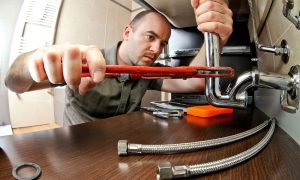It’s easy to overlook the complexity of your home’s plumbing system until you encounter a problem. Understanding the essentials of your home’s plumbing can prove extremely useful in identifying issues, performing minor repairs, and communicating effectively with professional plumbers. Let’s delve into the three fundamental aspects: water supply, plumbing fixtures, and drainage.
Plumber in Northern Virginia: Expertise in Water Supply System
The water supply system brings fresh water into your home. It is pressurized to allow flow through pipes and is split into two subsystems – one for cold water that goes directly to all points of use, and one for hot water that passes through a heater first.
- Cold Water Lines: These are connected directly to your water main and distribute cold water to all areas in your home.
- Hot Water Lines: These connect to a heating element (water heater) which heats the supplied cold water. The hot water line then distributes this heated water to required areas like showers and sinks.
Your Northern Virginia Plumber for All Plumbing Needs
Plumbing fixtures are end-points of a plumbing system. They include sinks, faucets, toilets, bathtubs, showers, dishwashers, washing machines etc. All these fixtures require both hot and cold water supply lines connected for their operation.
| Fixture | Required Supply Line |
| Sink | Hot & Cold |
| Toilet | Cold Only |
| Shower | Hot & Cold |
Exploring Plumbing Services in Northern Virginia
Equally essential as the supply system is the drainage or waste system. This utilizes different sized pipes and gravity to carry used or waste water away from your home safely into sewers or septic tanks. Vent stacks are also crucial in this system as they help maintain proper atmospheric pressure in drainpipes to ensure seamless flow of wastewater.
The key components include:
- Drain Pipes: These carry wastewater from the fixtures in your home out to the sewer or septic system.
- Vent Pipes: Vent pipes prevent air locks by allowing air into drain pipes, promoting smoother flow of wastewater.
- Trap: A trap is a curved pipe segment under each fixture that holds water, providing a seal to keep sewer gases from entering your home.
This beginner’s guide should give you a basic understanding of your home’s plumbing system. It’s always beneficial to have an understanding of your house’s infrastructure, especially in emergencies. However, always remember that larger issues should be left to professional plumbers who are trained and certified in handling all aspects of plumbing systems.
The water supply system is a crucial aspect of any building, be it residential or commercial. It ensures the smooth flow of water from the source to various areas within the structure.
- Direct Water Supply System
In a direct water supply system, all the points that require water in the building are directly connected to the municipal supply line. This implies that as long as there is a steady municipal supply, there will be constant water flow into the building.
The direct water supply system is commonly used in urban areas where municipal water supply is reliable. Some advantages include low installation cost and easy maintenance since it doesn’t require additional storage facilities.
- Indirect Water Supply System
Contrary to a direct system, an indirect water supply system involves storing municipal-supplied water before distributing it around the building. This method employs overhead tanks or underground sumps to store and distribute water across different parts of a structure via gravity.
This type of system provides an uninterrupted supply even when there are inconsistencies with the main municipal source. The indirect water supply system is ideal for larger buildings or those located in regions with unreliable municipal supplies.
- Dual Water Supply System
A dual water supply system incorporates both direct and indirect systems. Typically, cold-water appliances such as toilets and gardens are supplied directly from the mains whilst hot appliances like geysers receive stored (indirect) supplies.
This combination provides both efficiency and reliability; ensuring constant access to cold-water while still preparing for interruptions through stored supplies.
- Dual Pump System
Commonly used in high-rise commercial buildings, dual pump systems utilize two pumps: one providing direct pressurized flow from mains during high demand periods while another distributes stored supplies during low demand times or main supply interruption.
This system provides high pressure and flow rate, suitable for buildings with significant water demand.

Exploring the Best Plumbing Companies in Northern Virginia
The choice of water supply system often depends on factors such as:
- The reliability and pressure of the municipal supply
- The size and layout of the building
- The plumbing infrastructure already in place
- The building’s water demand
It’s therefore crucial to work with professional plumbers who are knowledgeable about these systems to ensure proper installation and operation.
Knowing what each type of pipe can do allows you to make informed decisions about your home’s plumbing system.
Expert Plumbing Services in Northern Virginia
- Long lifespan.
- Withstand high pressure.
- Fire-resistant.
However, they are more expensive than other options and require professional installation due to soldering requirements.
Finding Reliable Plumbing Contractors in Northern Virginia
- Affordable.
- Easy installation.
- Corrosion-resistant.
However, PVC pipes are not suitable for hot water supply lines as they can warp under high temperatures.
Northern Virginia Plumbing and PEX Pipes Solutions
It’s easy to install, resists scaling and corrosion, and ideal for water supply lines.
- Flexible and easy installation.
- Corrosion-resistant.
- Can be used with hot or cold water supplies.
However, it’s susceptible to UV damage; thus it shouldn’t be used outdoors where it could be exposed to sunlight.
They’re mainly used now for gas supply lines or as conduit for electrical wiring.
- Strong and durable.
- Withstand high pressure.
On the downside, they’re heavy, difficult to work with, and can corrode over time leading to leaks or reduced water pressure.
Cast Iron Pipes
Cast iron pipes are primarily used in sewer lines. However, they’re heavy and require professional installation due to their weight and the need for specialized tools.
- Durable.
- Ideal for underground sewer lines.
- Can withstand heavy loads.
However, these pipes are susceptible to rust over time and require regular maintenance.
A plumbing distribution system is a critical aspect of any building. It is responsible for the proper distribution of water throughout the structure. This system is composed of several core components, each playing a crucial role in its overall functionality. Let’s delve into understanding these essential components and how they function.
Supply Lines
Supply lines are the main arteries of any plumbing distribution system. They transport water from the main source to different areas within the property. Usually made from copper or plastic, they come in varying diameters, with larger ones used for carrying more significant volumes of water to bathrooms or kitchens.
Shut-Off Valves
Shut-off valves are fundamental safety features in a plumbing distribution system.
Water Meters and Pressure Regulators
These two components monitor and control water flow within the system:
- A water metermeasures the amount of water consumed by a property.
- A pressure regulatorensures that water pressure within the supply lines remains at safe levels.
Hot Water Heater
The hot water heater is another vital component, providing hot water for various uses like cooking, cleaning, or bathing.
Fixtures
Fixtures are end-points in your plumbing distribution system where water gets utilized. These include taps, showerheads, washing machines, dishwashers among others.
Understanding how these core components work together can help you maintain your plumbing distribution system more effectively:
- Water enters your property via the mainline connected to your local municipality’s supply.
- It passes through your water meter (measuring use) and pressure regulator (controlling pressure).
- The supply lines then distribute this water throughout your property.
- Shut-off valves allow you to control the flow of water to individual areas when needed.
- The water heater ensures a hot water supply for household tasks.
- Finally, the water reaches your fixtures for usage.
Regular maintenance of these core components can help ensure your plumbing distribution system remains efficient and functional. For instance, regularly checking your shut-off valves for leaks or signs of wear and tear can help prevent unnecessary water wastage. Similarly, keeping an eye on your water meter can help you track and manage your overall water consumption.
Understanding the core components of a plumbing distribution system is essential for every homeowner. It not only empowers you to perform basic troubleshooting tasks but also enables you to describe issues accurately to professional plumbers when needed.
A properly designed and installed plumbing system is integral to the overall health and efficiency of a building’s infrastructure. An often overlooked, yet critical component of this system is the drainage and ventilation subsystem. The drainage system removes waste water from the property, while the ventilation system prevents sewer gases from entering the living spaces. Together, they ensure that your plumbing system operates smoothly and safely.

Understanding Drainage Systems
The drainage part of a plumbing setup consists primarily of pipes that carry waste water away from sinks, toilets, showers, washing machines, dishwashers, and other appliances. It relies on gravity to transport this waste water from your home or business to either a municipal sewer or septic tank.
Drainage systems have several key components:
- Traps:These are curved sections of pipe located under sinks and other fixtures. They hold a small amount of water to prevent sewer gases from coming back up the drain.
- Cleanouts:These provide points of access for plumbers to clean out clogs or blockages.
- Drainpipes:These are large pipes that convey wastewater to the sewer or septic tank.
Significance of Ventilation Systems
Ventilation systems in plumbing allow air to enter the pipes which facilitates proper flow of water and waste through the drains. Without adequate ventilation, negative pressure can build up in the pipes as water is drained away which may lead to slow draining sinks or gurgling sounds.
Ventilation systems consist mainly of vent stacks that extend up through the roof allowing gases to escape into the atmosphere rather than lingering inside your home.
Plumbing vents also perform several vital functions:
- Equalizing Air Pressure:By allowing air into your plumbing system, vents help maintain equal air pressure inside your pipes. This equalization ensures water can flow freely and efficiently.
- Releasing Sewer Gases:Vent pipes expel sewer gases outside your home, keeping unpleasant odors from seeping into your living spaces.
- Preventing Vacuum Formation:Vent pipes prevent vacuums from forming in the drains which could disrupt the flow of water.
In summary, a well-designed and correctly installed plumbing system with the right balance of drainage and ventilation is central to the overall performance and efficiency of your household infrastructure. It ensures smooth operation, prevents sewer gas infiltration, tackles blockages efficiently, and maintains the longevity of your plumbing system. If you notice any signs of slow draining sinks, gurgling sounds or foul odors from your drains, it may indicate issues with your drainage or ventilation systems. Reach out to a professional plumber who can diagnose and rectify such issues before they escalate into more serious problems.
- Plumbers in Northern Virginia: An Essential Guide for Your Home’s Plumbing System
- Comprehensive Guide to Hiring Plumbers in Northern Virginia: 9 Steps for Effectively Managing Plumbing Emergency Situations
- Comprehensive Guide to Air Conditioning Repair in Northern Virginia: Top 10 Factors to Consider Before Replacing Your System
- Understanding the Importance of Air Conditioning Repair in Northern Virginia from Leading Industry Experts
- Comprehensive Guide on Air Conditioning Repair in Northern Virginia